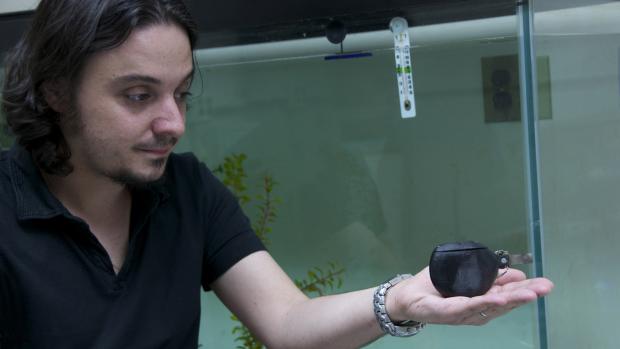Follow the (Robotic) Leader
NYU-Tandon Scientist Combines Mathematical Modeling and Advanced Materials to Create Robots to Lead Schools of Fish

Professor Maurizio Porfiri and his robot fish
Artificial intelligence? Done. Artificial leadership? Its origins may well be in the fish tanks and the algorithms in Maurizio Porfiri’s Brooklyn laboratories at the NYU Tandon School of Engineering. Here the assistant professor of mechanical engineering, best known for modeling advanced smart materials, is using those materials, plus a lot of mathematics and his love for animals and science fiction, to build robots that lead schooling fish.
Someday, Porfiri hopes, robots could lead fish away from the turbines of power plants. They could lead flocking birds to new wintering grounds if their forests have been destroyed and humans to safety when a fire breaks out.
Porfiri chose to start with the bait fish swimming in his tanks because their information-sharing is particularly rich: They make their decision on whether to school based upon what they see and the flow that they feel, which can be studied using fluid dynamics. Fish leaders, according to biologists’ published literature and Porfiri’s observations, beat their tails faster, mill about and accelerate to gain attention, gather a school and lead it.
Using a shallow, donut-shaped tank and cameras, the Tandon team began a mathematical journey into fish schooling in one-dimensional environments, reporting their results in the Journal of the Royal Society Interface. Meanwhile, they built silent, remotely controlled, fish-like robotic swimmers that fit in the palm of a hand, and their first technical paper on the robotic fish received the Best Robotics paper award at the 2009 American Society of Mechanical Engineers Conference on Dynamic Systems and Controls.
Since fish of different sizes and species school together, Porfiri correctly hypothesized that they would not only accept a robotic peer that was larger than themselves but also welcome it as a group leader.
To engage live shoal mates, he gave the robot other fish qualities. Foremost, it would have to swim silently, and its locomotion would have to closely match that of live fish. To achieve these goals, he employed ionic polymers that swell and shrink in response to electrical stimulation from a battery, propelling the robot. (Such biomimetic and innovative propulsion systems also motivated Porfiri’s recent research on energy harvesting in aquatic environments using ionic polymers.)
Since that initial research, Porfiri and his team have continued their studies on robotic leadership, more finely honing exactly how their robotic fish should move and look. They demonstrated, for example, that precisely calibrating the frequency at which a model’s tail beat was a major boon; because that motion affects the flow of the surrounding water, a live fish can be enticed into swimming in the resulting wake, so as to save energy. They also discovered that fish were more apt to follow their robotic counterparts if certain visual cues were magnified — if pigmentation was brighter, for example, or if the morphology, size, or aspect ratio were optimized.




